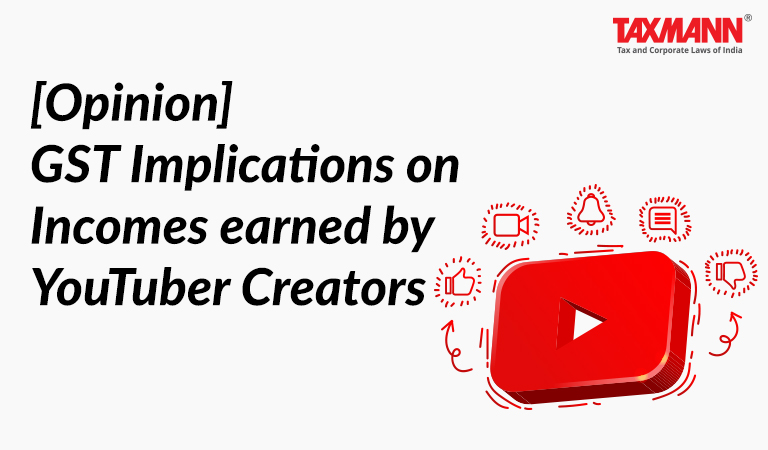[Opinion] GST Implications on Incomes earned by YouTuber Creators
- Blog|News|GST & Customs|
- 2 Min Read
- By Taxmann
- |
- Last Updated on 5 December, 2022

YouTube is undoubtedly the TV for the millennials. I was recently at a family gathering and was talking to the NexGen kids about what they want to become when they grow up. To my surprise, one of them said, he want to become a YouTube creator. I said, that is fine, but, what do you want to do full-time? He has not changed his response. He said he wants to create content as a full-time job and post it on YouTube. No doubt, many of you who are reading this piece of article would have also got the same response in your gatherings. The immediate question that arises, if someone wants to pursue this as full time, will they be earning which is normally equivalent to a full time conventional job? I did a bit research and understood that in 2020, YouTube has paid Rs 6,800 Crores to YouTube Creators in India as part of their YouTube Partner Program (for brevity ‘YPP’). That roughly translates to 6.84 lakh full time jobs. The numbers are astronomical, both the revenues earned and the YouTube Creators. Maybe we have all taken a wrong job (pun intended).
YouTube pays the content creators in 10 different ways. The significant portion among all the pay-outs by YouTube is the advertisement revenue. Once the content creator meets the threshold set by YouTube, he will be in a position to monetise his videos. YouTube pays roughly 55% of the advertisement revenue to the content creators and retain the balance.
In this piece, we are only dealing with the tax implications on the share of advertisement revenue that is paid out by YouTube to content creators. Let us understand the tax implications by taking a case study. Mr Bored is an individual is a YouTube content creator located in India. He updates original content every week and has a huge subscriber base. He has qualified for the benefits under YPP and he was being paid by YouTube on a monthly basis, share of advertisement revenue, let us say, Rs 2 lakhs.
The modus operandi is simple. Mr Bored creates a video. Uploads into his channel. Selects that the video is open for monetisation. YouTube based on its ads algorithm plays advertisements in the video posted by Mr Bored. YouTube collects money from advertisers as per their agreement. YouTube pays Mr Bored, a part of such advertisement revenue.
Mr Bored earns Rs 24 lakhs per the entire year. The question that arises for consideration is, what are the implications on the income earned by Mr Bored from the perspective of GST laws. Let us proceed to analyse the same.
In order to understand the tax implications, it is a pre-requisite to understand, as to, what is the nature of supply, who is the supplier, who is the recipient, what is the location of supplier, what is location of recipient and finally, where is the place of supply.
Click Here To Read The Full Article
Disclaimer: The content/information published on the website is only for general information of the user and shall not be construed as legal advice. While the Taxmann has exercised reasonable efforts to ensure the veracity of information/content published, Taxmann shall be under no liability in any manner whatsoever for incorrect information, if any.

Taxmann Publications has a dedicated in-house Research & Editorial Team. This team consists of a team of Chartered Accountants, Company Secretaries, and Lawyers. This team works under the guidance and supervision of editor-in-chief Mr Rakesh Bhargava.
The Research and Editorial Team is responsible for developing reliable and accurate content for the readers. The team follows the six-sigma approach to achieve the benchmark of zero error in its publications and research platforms. The team ensures that the following publication guidelines are thoroughly followed while developing the content:
- The statutory material is obtained only from the authorized and reliable sources
- All the latest developments in the judicial and legislative fields are covered
- Prepare the analytical write-ups on current, controversial, and important issues to help the readers to understand the concept and its implications
- Every content published by Taxmann is complete, accurate and lucid
- All evidence-based statements are supported with proper reference to Section, Circular No., Notification No. or citations
- The golden rules of grammar, style and consistency are thoroughly followed
- Font and size that’s easy to read and remain consistent across all imprint and digital publications are applied





